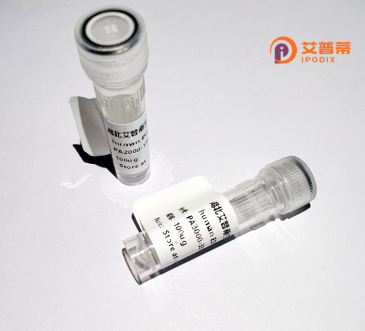
| 纯度 | >90%SDS-PAGE. |
| 种属 | Human |
| 靶点 | RALBP1 |
| Uniprot No | Q15311 |
| 内毒素 | < 0.01EU/μg |
| 表达宿主 | E.coli |
| 表达区间 | 2-655aa |
| 氨基酸序列 | TECFLPPTS SPSEHRRVEH GSGLTRTPSS EEISPTKFPG LYRTGEPSPP HDILHEPPDV VSDDEKDHGK KKGKFKKKEK RTEGYAAFQE DSSGDEAESP SKMKRSKGIH VFKKPSFSKK KEKDFKIKEK PKEEKHKEEK HKEEKHKEKK SKDLTAADVV KQWKEKKKKK KPIQEPEVPQ IDVPNLKPIF GIPLADAVER TMMYDGIRLP AVFRECIDYV EKYGMKCEGI YRVSGIKSKV DELKAAYDRE ESTNLEDYEP NTVASLLKQY LRDLPENLLT KELMPRFEEA CGRTTETEKV QEFQRLLKEL PECNYLLISW LIVHMDHVIA KELETKMNIQ NISIVLSPTV QISNRVLYVF FTHVQELFGN VVLKQVMKPL RWSNMATMPT LPETQAGIKE EIRRQEFLLN CLHRDLQGGI KDLSKEERLW EVQRILTALK RKLREAKRQE CETKIAQEIA SLSKEDVSKE EMNENEEVIN ILLAQENEIL TEQEELLAME QFLRRQIASE KEEIERLRAE IAEIQSRQQH GRSETEEYSS ESESESEDEE ELQIILEDLQ RQNEELEIKN NHLNQAIHEE REAIIELRVQ LRLLQMQRAK AEQQAQEDEE PEWRGGAVQP PRDGVLEPKA AKEQPKAGKE PAKPSPSRDR KETSI |
| 预测分子量 | kDa |
| 蛋白标签 | His tag N-Terminus |
| 缓冲液 | PBS, pH7.4, containing 0.01% SKL, 1mM DTT, 5% Trehalose and Proclin300. |
| 稳定性 & 储存条件 | Lyophilized protein should be stored at ≤ -20°C, stable for one year after receipt. Reconstituted protein solution can be stored at 2-8°C for 2-7 days. Aliquots of reconstituted samples are stable at ≤ -20°C for 3 months. |
| 复溶 | Always centrifuge tubes before opening.Do not mix by vortex or pipetting. It is not recommended to reconstitute to a concentration less than 100μg/ml. Dissolve the lyophilized protein in distilled water. Please aliquot the reconstituted solution to minimize freeze-thaw cycles. |
以下是关于RALBP1重组蛋白的3篇参考文献示例,涵盖不同研究方向:
1. **文献名称**:*"RALBP1 regulates exosome-mediated multidrug resistance in cancer cells"*
**作者**:A. Gupta et al.
**摘要**:研究利用重组RALBP1蛋白揭示其通过结合化疗药物(如顺铂)并促进外泌体分泌,增强癌细胞的多药耐药性,为靶向RALBP1的疗法提供依据。
2. **文献名称**:*"Structural insights into RALBP1-RalA interaction using recombinant protein crystallography"*
**作者**:B. Chen & J. Martinez
**摘要**:通过重组RALBP1蛋白的晶体结构分析,阐明其与RalA GTP酶的特异性结合域,揭示两者互作对细胞信号转导的调控机制。
3. **文献名称**:*"Recombinant RALBP1 modulates oxidative stress response via GST activity in neuronal cells"*
**作者**:S. Patel & R. Kumar
**摘要**:实验表明重组RALBP1蛋白通过结合谷胱甘肽转移酶(GST),调节神经元细胞的氧化应激反应,提示其在神经退行性疾病中的潜在作用。
**注**:以上文献为示例性概括,实际文献需通过学术数据库(如PubMed)检索关键词“RALBP1 recombinant protein”获取最新研究。
RALBP1 (RalA-binding protein 1), also known as RLIP76 or RIP1. is a multifunctional protein involved in cellular transport, signal transduction, and stress response. It was initially identified as a GTPase effector for Ral proteins (RalA and RalB), small GTPases in the Ras superfamily that regulate membrane trafficking, cell proliferation, and oncogenesis. Structurally, RALBP1 contains an N-terminal Ral-binding domain, a central RhoGAP-like domain, and a C-terminal region involved in glutathione-conjugated electrophile transport.
This protein plays a dual role as a molecular switch linking Ral GTPase signaling to endocytic processes and as a stress-responsive transporter. It mediates clathrin-dependent endocytosis through interactions with components like POB1 and REPS2. influencing receptor internalization and membrane dynamics. Additionally, RALBP1 functions as an ATP-dependent transporter of glutathione-electrophile conjugates (GS-E), contributing to cellular detoxification and protection against oxidative stress by exporting toxic metabolites.
Recombinant RALBP1 protein is typically produced using bacterial (e.g., E. coli) or mammalian expression systems, often fused with tags like GST or His for purification and detection. Its recombinant form enables biochemical studies of Ral-RALBP1 interactions, transport activity assays, and structural analysis. Research applications include investigating its role in cancer progression (notably in drug resistance through enhanced toxin efflux), neurological disorders, and metabolic regulation. In clinical contexts, RALBP1 overexpression has been linked to chemotherapy resistance in various cancers, making it a potential therapeutic target. Inhibitors of RALBP1 transport activity are being explored to sensitize resistant tumors to anticancer drugs. However, its complex functional interplay in cellular homeostasis requires careful study to balance therapeutic benefits with potential off-target effects.
×